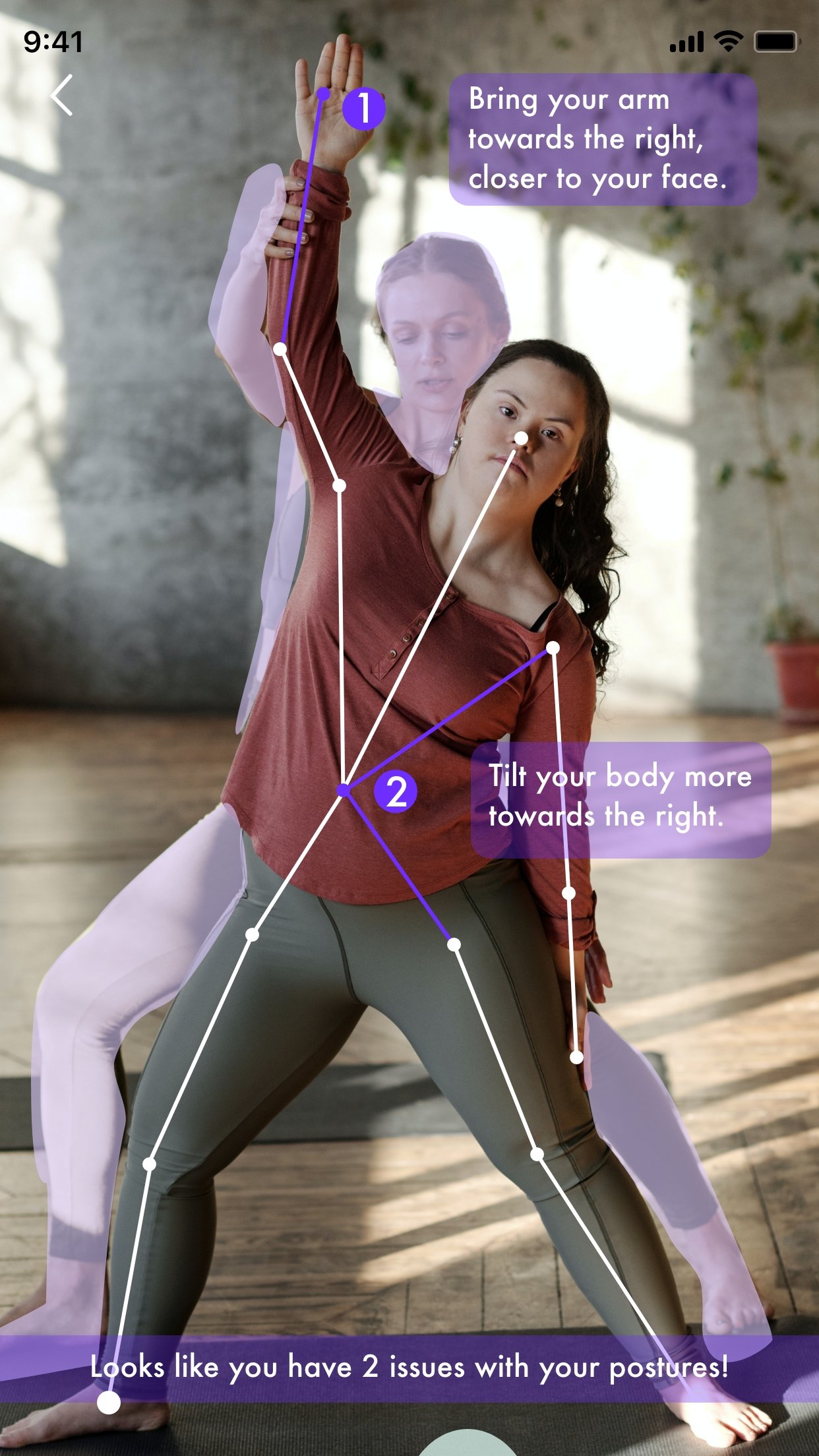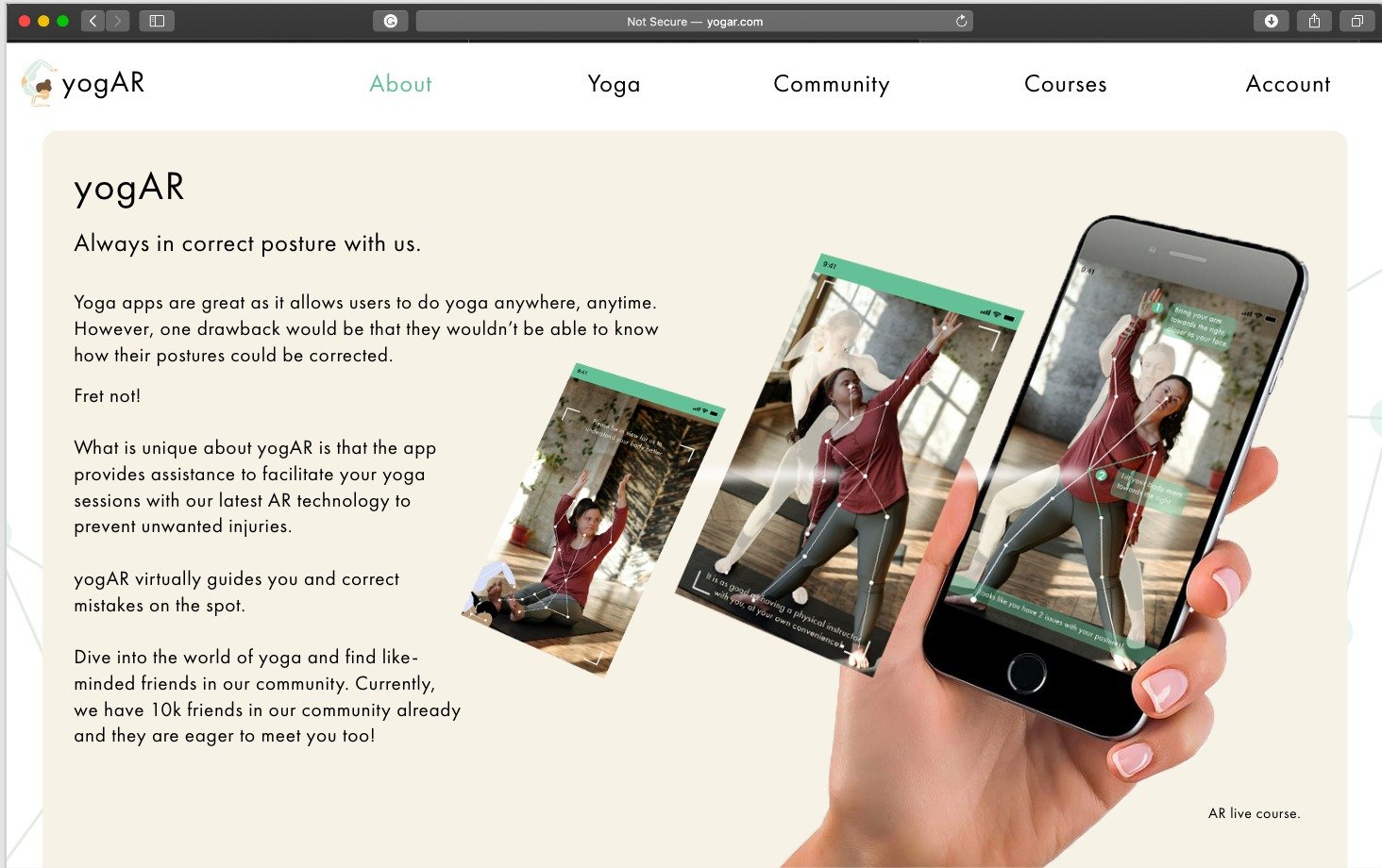
Yoga apps are great as it allow users to do yoga anywhere, anytime. However, users aren’t able to check their postures during practice. Incorrect postures over time may lead to injuries.
About
Instagram Story Advertisement on YogAR
YogAR uses AR technology to detect and correct postures in real-time. The use of a visual and audio guide provides a friendly learning environment for all yogis. Yogis can also communicate with professional yoga instructors and meet like-minded friends in their journey of mastering yoga independently at home.
Awarded Indigo Design Award, Bronze, in UX, Interface, and navigation category
At A Glance
App Design
App in motion
Courses
Courses with different difficulty levels.
Profile
For users to keep track of their progress.
Demo
Frame 3.
Community
For users to log into their accounts.
Login
For users to log into their accounts.
Library (after clicking in)
Educates, demo pose for users.
Library
A compilation of yoga poses to learn.
Demo
Frame 2.
Demo
Frame 1.
Website Design
Desktop View
Mobile View
Key Process Developments
Key Research
Stress can trigger anxiety and depression, cause sleep problems, social withdrawal, angry outbursts, obsessive compulsive behaviours and even self harm
According to a Cigna 360 Well-Being Survey done in 2019, 92% of working Singaporeans report feeling stressed out. Mr Philip Ang, a psychologist of 20 years, said that at every stress management talk he has conducted in schools, 70%-80% raises their hand whenever he asked who’s stress.
Queries for yoga and meditation apps such as “mindfulness apps” or “yoga for beginners app” have increased by 65%
Majority of respondents do yoga at home (67%), followed by gym (43%), yoga studios (38%), outdoors (32%), yoga or wellness festival (20%), others (20%)
“Ahead of the celebrations, doctors and yoga instructors are emphasising a key and often overlooked element of yoga mania – unsupervised it can cause serious injuries and strain. In a time of Youtube videos, yoga CDs, and DIY apps, it is still essential to exercise caution, or practice under expert guidance.”
As seen in a survey, nearly 30000 yoga related injuries were seen in the US hospital emergency department from 2001-2004. This may also increase the stress levels of users and have a reverse effect when they wanted to decrease through yoga
Key Competitors
1 - Pocket Yoga
Has detailed voice and visual instructions that guide users through each pose and breath
Over 200 illustrated images to show correct posture and alignment
Has a dictionary to yoga terminologies
27 sessions designed by experienced instructors with different difficulties
Plus point: Illustrations can move and allow users to view the full movement of the poses while reading explanations. Convenient, and could be used on both the mobile phone and Apple watch.
Pain point: Not free. Relies on a multitude of data about health, and there’s an overload of information given on every page which may be overwhelming for beginners/users.
2 - Daily Yoga
Offers 500+ asanas, 70+ yoga programmes, 500+ guided yoga, pilates, meditation sessions plus largest yoga pose library
20 yoga masters
Smart coach feature help users to pick the right class for you. Will lead a session a day for 30 days
Plus point: Has smart coach to give assistance to users when they do not know where to begin. App gamifies participation to draw users in to come back daily for rewards.
Pain point: App does not provide modification for the less flexible as it assumes general fitness level for all users. There are also no male-oriented programmes catered.
Before YogAR, there were 2 other concepts – Yoga Live, and Yoga Teacher.
Selecting a colour palette…
I felt that green works the best here as there’s positive relations to health and fitness, and it also adds to the vibrancy of the app. However, I realised the visual cues may require some tweaking as it may be confusing for the users when they see green though the app flagged out their inaccuracy when holding a pose.
App icon explorations
UX/UI explorations
Food For Thought
I started the project by doing lots of research on AR/VR, which was an area of interest I had. I wanted to learn about the latest technology, and what may be possible in the near future. After weeks of research, I realised that there was no mobile applications available with AR/VR functions for yogis (people who do yoga). I questioned why, and got down to work after some discussion with my lecturer. Mmm, exciting.
My main struggles back then was the lack of experience in softwares like Adobe XD and AE. I only had basic lessons on them, and had to self-learn the more complicated functions in order to bring the app alive. I was also not sensitive to typography, and white spaces – with the tendency to overload contents on the same page. Needless to say, motion tracking was a big challenge for a newbie like myself.
Despite the challenges, I managed to pull through the entire project! Personally, I felt that this project was where my skillsets grew the most out of the 3 years of pursuing a diploma in Communication design. Ultimately, my aim was to create a one-stop destination app for yoga enthusiasts who practices yoga at home.



























